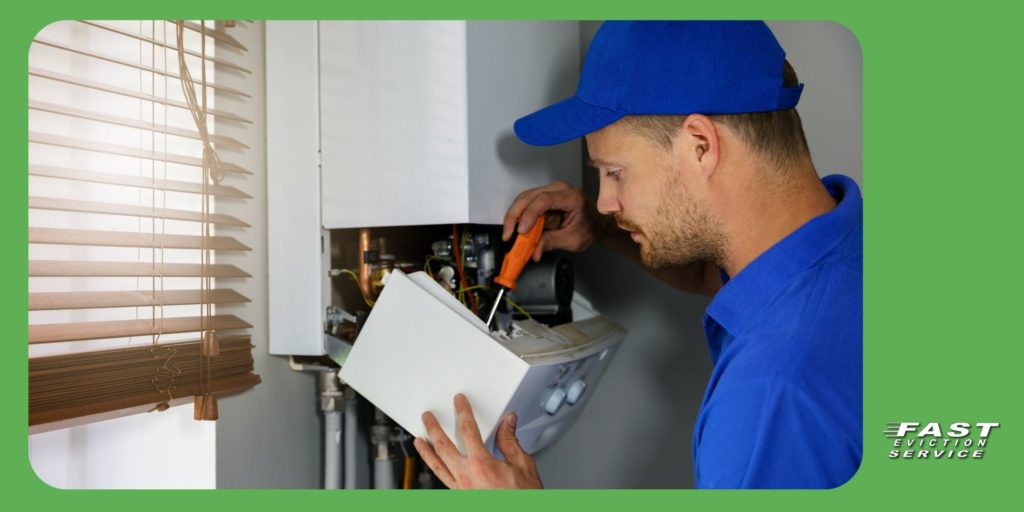You are represented at all times by one of our California Eviction Attorneys | 1-800-686-8686 | intake@fastevict.com | Se habla español
Can Landlords Charge Renters for Repairs if They Do the Repairs Themselves?
Updated 12/13/24
Whether or not a California landlord can charge tenants for repairs that are done by either a contractor or by the landlord depends upon whether the need for the repair is the result of damages or normal wear and tear.

What is normal wear and tear in a rental unit?
Normal wear and tear of a rental unit is the physical deterioration of the property from normal regular use. These include things that time and regular daily use can cause to be worn like electrical switches, frayed pull strings on blinds, peeling wallpaper or faded curtains and dirty window screens.
Related: What can you do if your property has been damaged by your tenant?
Wear and tear generally does not include occupants and their guests’ accidents or carelessness which are considered damages. Fingerprints and faded paint would constitute wear and tear, while large stains on the wall, ripped wallpaper or broken molding would be considered damage.
If the garbage disposal is 20 years old and it breaks, that’s wear and tear. But if a spoon accidentally goes down it breaking it, that’s damages due to negligence. If the tenants fail to remove the lint in a dryer and it overheats, that’s damages due to negligence.
Landlords are expected to keep up the habitability of the rental such as leaks, exterior painting and calking, electrical repairs that are usually paid for by the landlord to a contractor. However, if the repair is the result of an accident or damages caused by the tenant, and the landlord is capable of making those repairs, there are several good reasons for the landlord to do it.
The language in the lease or rental agreement is key. It should cover what happens when renter’s negligence or recklessness are the cause of the repair. Clearly state that the landlord has the prerogative to chose the contractor. By signing the agreement, the tenant gives permission for you or your contractor to do the work.
California state tenancy codes require renters to notify the landlord when damage occurs. If the damage affects the habitability of the premises, a landlord must respond within 24 hours. One advantage of having the landlord do the repair is they know and care about the property best, and so can often get to the heart of the problem and know what is needed to fix it fastest.
Repairs often need immediate attention. Contractors often take time to become available and the landlord can frequently be the fastest to respond. Many repairs require follow-up checking which may also be most efficient for the landlord to do.
If the repair is the result of damages rather than normal wear and tear, and the landlord is qualified to do the repair, they can do it themselves and bill the tenant the same as if they had hired a contractor to do it. However, they need to charge reasonable market rates to do so.
How much can a landlord charge for damages?
In California, the landlord may use the tenant’s security deposit to cover damages caused by the tenant. If the security deposit doesn’t cover the cost, then the landlord can bill the tenant for the additional costs.
Related: California Security Deposit Laws: What landlords must know
Most states like California have provisions that determines the reasonableness of wear and tear, which often depends on the tenants’ length of residency. For instance, if the tenants lived in the property for three years, it may be reasonable to expect to paint the walls and clean the carpets.
Many California courts will allow you to prorate the useful life of a damaged item. Under California landlord-tenant guidelines, a carpet’s useful life is eight to 10 years. If there is a major spill that requires the carpet to be replaced, then the cost of replacing the carpeting would have to be prorated over a 10-year period. The cost of replacing the carpet after 10 years is the responsibility of the landlord.
An itemized statement should always be provided by the landlord whether the cost of the repair from damages was fixed by the landlord or a contractor. It should detail any charges, including the hourly labor rate, the number of hours spent on the repair, what materials were used, the cost of those materials and any additional costs like transportation to get materials.
Make all costs carefully itemized and be sure the labor rate is the going market rate to avoid disputes over security deposits which is one of the most common causes of tenant lawsuits!
California state law indicates that a landlord can be charged up to three times the deposit as a fine for illegally withholding money from former tenants for labor and repairs. Protect yourself by making the labor rate completely reasonable if were to ever be reviewed by a judge.







